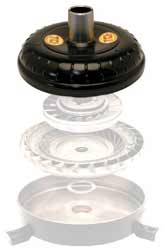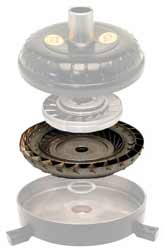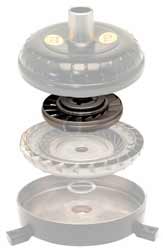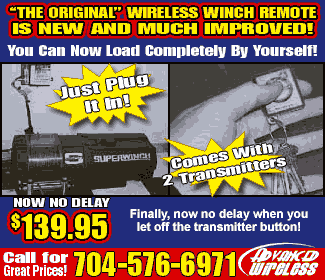| 
 Picture this: You have a water hose in your hand and there
is a fan standing in front of you. When you spray water on
the blades, they will begin to spin. If you play with it
a little more and change the force at which the water is
hitting the blades and the angle at which you are spraying,
the blades will speed up or slow down. The Pump of the torque
converter represents you holding the water hose and the turbine
of the converter represents the fan. Picture this: You have a water hose in your hand and there
is a fan standing in front of you. When you spray water on
the blades, they will begin to spin. If you play with it
a little more and change the force at which the water is
hitting the blades and the angle at which you are spraying,
the blades will speed up or slow down. The Pump of the torque
converter represents you holding the water hose and the turbine
of the converter represents the fan.
The fluid then enters the blades of the “Turbine”,
which is connected to the transmission via the input shaft.
The turbine/input shaft causes the transmission to spin the
planetary that connects the output shaft of the transmission,
which is connected to the driveshaft, then rear-end, the
axles, which basically moves your car. You can see in the
graphic below that the blades of the turbine are curved.
This means that the fluid, which enters the turbine from
the outside, has to change direction before it exits the
center of the turbine. It is this directional change that
causes the turbine to spin.
 In order to change the direction of a moving object, you
must apply a greater force to that object. It doesn't matter
if the object is a car or a drop of fluid. And whatever applies
the force that causes the object to turn must also feel that
force, but in the opposite direction. So as the turbine causes
the fluid to change direction, the fluid causes the turbine
to spin. In order to change the direction of a moving object, you
must apply a greater force to that object. It doesn't matter
if the object is a car or a drop of fluid. And whatever applies
the force that causes the object to turn must also feel that
force, but in the opposite direction. So as the turbine causes
the fluid to change direction, the fluid causes the turbine
to spin.
The fluid exits the turbine at the center, moving in a different
direction than when it entered. The fluid exits the turbine
moving opposite the direction that the pump (and engine)
is turning. If the fluid were allowed to hit the pump, it
would slow the engine down, wasting power. This is why a
torque converter has a “Stator.”
The “Stator” sends the fluid returning from
the Turbine to the Pump.This improves the efficiency of the
torque converter.
 The “Stator” resides in the very center of the
torque converter. It is the “brain” of the converter.
Its job is to redirect the fluid returning from the turbine
before it hits the pump again. This dramatically increases
the efficiency of the torque converter. The “Stator” resides in the very center of the
torque converter. It is the “brain” of the converter.
Its job is to redirect the fluid returning from the turbine
before it hits the pump again. This dramatically increases
the efficiency of the torque converter.
The “Stator” has a very aggressive blade design
that almost completely reverses the direction of the fluid.
A one-way clutch called a “sprag” (inside the
stator) connects the stator to a fixed shaft in the transmission
called a “Stator Support.” Because of this arrangement,
the stator cannot spin with the fluid -- it can spin only
in the opposite direction, forcing the fluid to change direction
as it hits the stator blades.
Something a little bit tricky happens when the car gets
moving. There is a point & time at which both the pump
and the turbine are spinning at almost the same speed (the
pump always spins slightly faster). At this point, the fluid
returns from the turbine, entering the pump already moving
in the same direction as the pump, so the stator is not needed.
It’s one-way clutch or sprag allows it to “freewheel.”
Even though the turbine changes the direction of the fluid
and flings it out the back, the fluid still ends up moving
in the direction that the turbine is spinning because the
turbine is
ADVERTISEMENT
 |
spinning faster in one direction than the fluid
is being pumped in the other direction. The fluid is being
flung out the back in one direction, but not as fast as it
was going to start with in the other direction.
At these speeds, the fluid actually strikes the backsides
of the stator blades, causing the stator to freewheel on
its one-way clutch so it doesn't hinder the fluid moving
through it.
|
